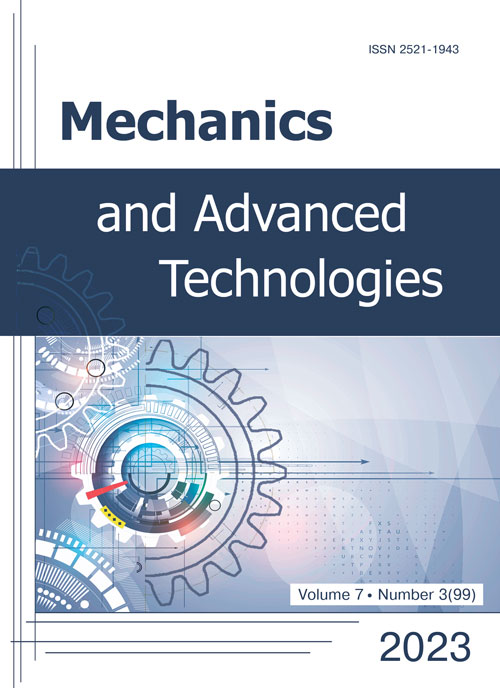Effective decoupling method for derivation of eigenfunctions for closed cylindrical shell
DOI:
https://doi.org/10.20535/2521-1943.2023.7.3.282190Keywords:
decoupling, coupled problem, closed cylindrical shell, eigenfunction, iterative procedure, main homogeneous equation, auxiliary particular solution, concentrated forceAbstract
By expansion into Fourier series along the circumferential coordinate, the problem for elastic thin-walled closed cylindrical shell is reduced to 8th order differential equation with respect to axial coordinate. In spite that the general structure of eigenvalues for this equation was known starting from 60-s of last century, they were derived only to some simplified versions of the shell theory. So, the main goal of paper consists in development of the general procedure for determination of the eigenvalues. The idea is based on that the theory of shell is actually formed by two much simple problems: the plane task of elasticity and the plate problem, each of them is reduced to much easily treated biquadratic equation. So, we start from either of two problems (main problem) while not taking into account the impact from another (auxiliary) problem. After computing its eigenfunctions, we gradually introduce the influence of auxiliary problem by presenting its functions as linear combination of functions for main problem. The results of calculation show the perfect accuracy of the method for any desired number of significant digits in eigenvalues. The comparison with known results for concentrated radial force shows the perfect ability to solve any boundary problem with any desirable accuracy.
References
- D. S. Houghton and D. J. Johns, “A comparison of the characteristic equations in the theory of circular cylindrical shells”, Aeronautical Quarterly, vol. 12, no. 3, pp. 228–236, 1961. DOI: https://doi.org/10.1017/S0001925900002080.
- Shao Wen Yuan, “Thin cylindrical shells subjected to concentrated loads”, Quart. App. Math., vol. 4, no. 1, pp. 13–26, April, 1946. DOI: https://doi.org/10.1090/qam/16031.
- I. Holand, “Characteristic equations in the theory of circular cylindrical shells”, Aeronautical Quarterly, vol. 13, no. 1, pp. 88–91, 1962. DOI: https://doi.org/10.1017/S0001925900002262.
- L. S. D. Morley, “An improvement on Donnell's approximation for thin-walled circular cylinders“, Quart. J. Mech. App. Math., vol. 12, no. 1, pp. 89–99, 1959. DOI: https://doi.org/10.1093/qjmam/12.1.89.
- D. Ren and K.-C. Fu, “Solutions of complete circular cylindrical shell under concentrated loads”, Journal of Engineering Mechanics, vol. 127, no. 3, pp. 248–253, 2001. DOI: https://doi.org/10.1061/(ASCE)0733-9399(2001)127:3(248).
- F. I. Niordson, Shell theory. New York: Elsevier Science, 1985.
- C. R. Calladine, Theory of shell structures. Cambridge University Press, 1983. DOI: https://doi.org/10.1017/CBO9780511624278.
- V. Z. Vlasov, The general theory of shell and its practical applications. Moscow: Gostechizdat, 1949.
- I. I. Feier, B. N. Leis, X.-K. Zhu, R. B. Stonesifer, J. S. Stavrakas and D. D’Eletto, “Experimental strain measurements on large diameter mitered pipe joints,” in 2010 8th International Pipeline Conference, Volume 1. Calgary, Alberta, Canada, 2010, pp. 881-891. DOI: https://doi.org/10.1115/IPC2010-31583.
- A. E. Green and W. C. Emmerson, “Stresses in a pipe with a discontinuous bend”, Journal of the Mechanics and Physics of Solids, vol. 9, no. 2, pp. 91–104, 1961. DOI: https://doi.org/10.1016/0022-5096(61)90027-8.
- E. L. Axelrad, Elastic Shells. Moscow: Nauka, 1976.
- I. V. Orynyak and S. A. Radchenko, “Analytical and numerical solution for a elastic pipe bend at in-plane bending with consideration for the end effect”, International Journal of Solids and Structures, vol. 44, no. 5, pp. 1488–1510, 2007. DOI: https://doi.org/10.1016/j.ijsolstr.2006.06.025.
- B. V. Nerubailo, “Radial displacement of a long cylindrical shell subjected to radial concentrated forces”, Soviet Applied Mechanics, vol. 10, no. 10, pp. 1128–1131, 1974. DOI: https://doi.org/doi.org/10.1007/BF00882358.
- V. P. Ol'shanskii, “Maximal deflection of cylindrical shells under a concentrated force”, Strength of Materials, vol. 22, no. 10, pp. 1523–1526, 1990. DOI: https://doi.org/10.1007/BF00767243.
- S. A. Karamanos, “Bending instabilities of elastic tubes”, International Journal of Solids and Structures, vol. 39, no. 8, pp. 2059–2085, 2002. DOI: https://doi.org/10.1016/S0020-7683(02)00085-9.
- N. Silvestre, “Generalised beam theory to analyse the buckling behaviour of circular cylindrical shells and tubes” Thin-Walled Structures, vol. 45, no. 2, pp. 185–198, 2007. DOI: https://doi.org/10.1016/j.tws.2007.02.001.
- I. Orynyak and Y. Dubyk, “Approximate formulas for cylindrical shell free vibration based on Vlasov’s and enhanced Vlasov’s semi-momentless theory,” in ASME 2018 Pressure Vessels and Piping Conference. Volume 8: Seismic Engineering. Prague, Czech Republic, 2018. DOI: https://doi.org/10.1115/PVP2018-84932.
- A. L. Goldenveizer, Theory of elastic thin shells. Moscow: Gostekhteoretizdat, 1953.
- A. Oryniak and I. Orynyak, “Application of Short and Long (Enhanced Vlasov's) Solutions for Cylindrical Shell on Example of Concentrated Radial Force”, J. Pressure Vessel Technol., vol. 143, no. 1, p. 014501, 2021. DOI: https://doi.org/10.1115/1.4047828.
- I. Orynyak and A. Oryniak, “Efficient Solution for Cylindrical Shell Based on Short and Long (Enhanced Vlasov’s) Solutions on Example of Concentrated Radial Force”, in ASME 2018 Pressure Vessels and Piping Conference, Vol. 3A: Design and Analysis. Prague, Czech Republic, 2018. DOI: https://doi.org/10.1115/PVP2018-85032.
- I. Orynyak and Y. Bai, “Coupled approximate long and short solutions versus exact Navier and Galerkin ones for cylindrical shell under radial load”, Thin-Walled Structures, vol. 170, p. 108536, 2022. DOI: https://doi.org/10.1016/j.tws.2021.108536.
Downloads
Published
How to Cite
Issue
Section
License
Copyright (c) 2023 Гліб Юдін, Ігор Ориняк

This work is licensed under a Creative Commons Attribution 4.0 International License.
Authors who publish with this journal agree to the following terms:
- Authors retain copyright and grant the journal right of first publication with the work simultaneously licensed under CC BY 4.0 that allows others to share the work with an acknowledgement of the work's authorship and initial publication in this journal.
- Authors are able to enter into separate, additional contractual arrangements for the non-exclusive distribution of the journal's published version of the work (e.g., post it to an institutional repository or publish it in a book), with an acknowledgement of its initial publication in this journal.
- Authors are permitted and encouraged to post their work online (e.g., in institutional repositories or on their website) prior to and during the submission process, as it can lead to productive exchanges, as well as earlier and greater citation of published work











